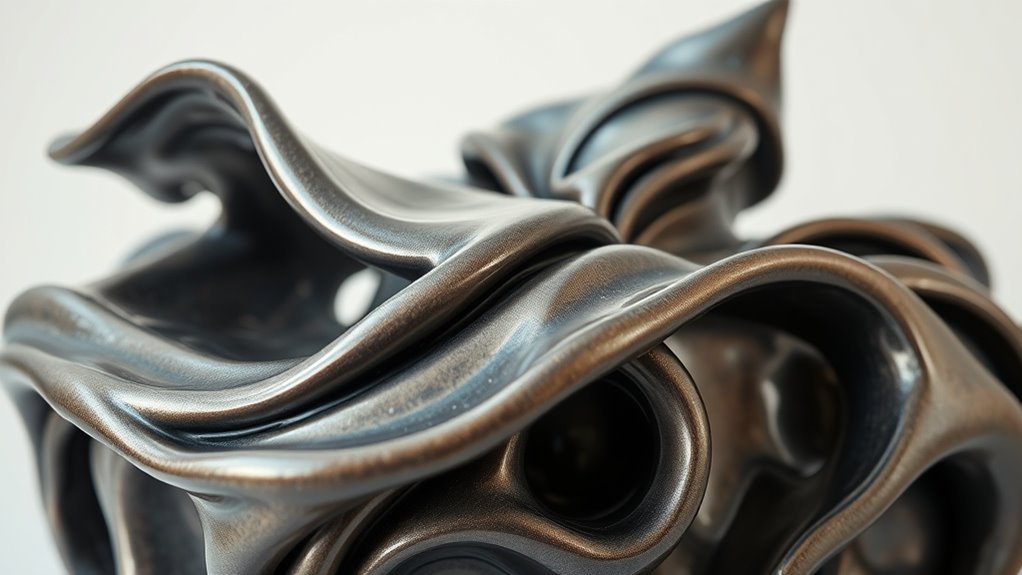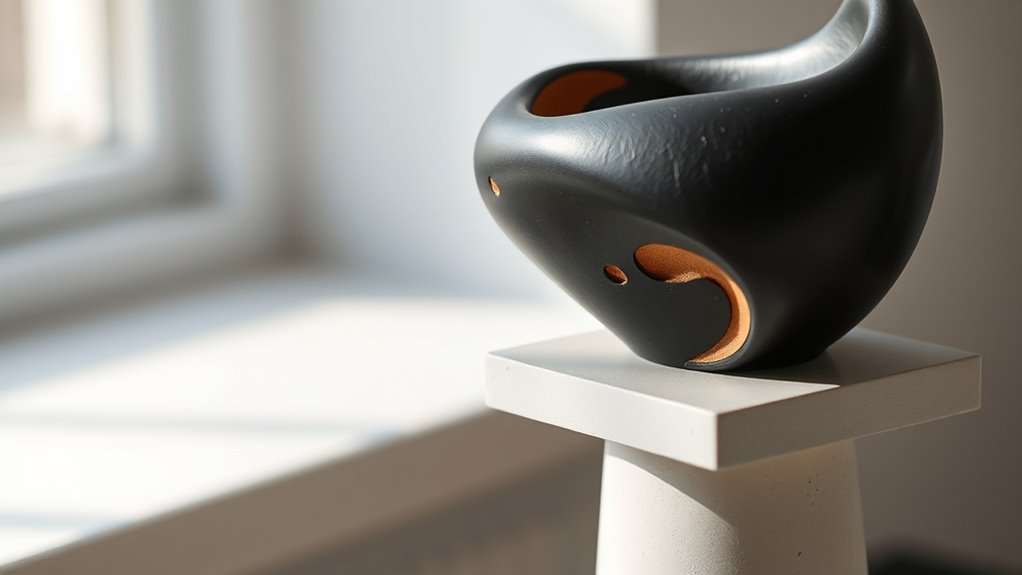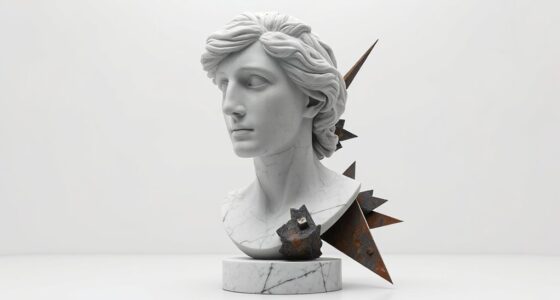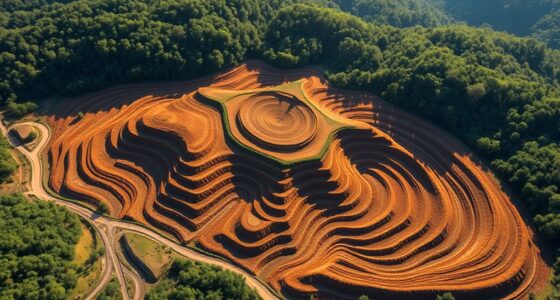Contemporary ceramics have transformed from traditional craft into a respected form of fine art by blending innovative techniques, diverse materials, and cultural influences. Artists push boundaries with sculptural forms, social messages, and experimental methods using ceramics, glass, metal, and recycled materials. Major exhibitions and recognition help elevate the medium on the global stage. To discover how this evolution continues to shape the art world and inspire new creations, explore further insights below.
Key Takeaways
- Contemporary ceramics have evolved from traditional craft into recognized fine art through innovative techniques and expressive forms.
- Pioneering artists integrating new materials and cross-disciplinary approaches have elevated ceramics’ artistic status.
- Modern practices include digital fabrication, unconventional materials, and environmental themes, expanding creative possibilities.
- Exhibitions, awards, and collector interest have significantly increased recognition of ceramics in the contemporary art world.
- The field continues to innovate with collaborations, sustainable practices, and immersive technologies shaping its future.
The Historical Roots of Ceramic Art and Its Evolution

The roots of ceramic art stretch back to prehistoric times, where early humans shaped clay for both practical and ritual purposes. Around 28,000 BCE, a female figurine was crafted in the Czech Republic, marking one of the earliest artifacts. During the Paleolithic period, cultures like Gravettian created iconic figurines such as the Venus of Dolní Věstonice. Early pottery vessels appeared in Japan around 16,000 BCE, serving functional needs. Before Neolithic pottery, stone containers were used from 12,000 to 6,000 BCE. In the Neolithic era, widespread pottery emerged, with innovations like the potter’s wheel around 3,500 BCE. These advancements laid the foundation for ceramics’ evolving role, blending art, ritual, and practicality across civilizations. Additionally, the development of ceramic techniques throughout history has enabled artisans to create increasingly sophisticated and expressive works of art. The cultural significance of ceramics continues to grow as contemporary artists explore new forms and materials, often integrating modern technology to push the boundaries of traditional craftsmanship. Furthermore, the evolution of ceramic methods has been influenced by technological innovations, which have enabled artists to experiment with new materials and tools.
Pioneering Artists Who Reshaped Ceramics as Fine Art

You can see how pioneering artists transformed ceramics into a respected art form by experimenting with new techniques and forms. Their innovative approaches and cross-disciplinary influences challenged traditional boundaries and expanded what ceramics can express. As a result, their work has earned recognition and left a lasting legacy in the art world. Incorporating craftsmanship and attention to detail, these artists elevated ceramics beyond functional objects to become celebrated works of art. Their ability to blend traditional techniques with contemporary concepts has been crucial in redefining the medium’s artistic potential, often utilizing innovative methods to push the genre further. Furthermore, the integration of contemporary art practices has helped bridge the gap between craft and fine art, fostering greater appreciation and understanding of ceramics in the broader art community. Additionally, exploring literary humor and symbolism in their work can deepen the viewer’s engagement and interpretation.
Innovative Artistic Approaches
- Porcelain books whisper stories of exile and memory, revealing how contemporary ceramics can serve as vessels for storytelling and cultural reflection. This narrative quality highlights the potential of ceramics to evoke emotional and historical resonance.
- Organic textures evoke nature’s delicate beauty, emphasizing the tactile and sensory qualities that artists explore to connect viewers with the natural world. Such techniques often utilize material versatility to mimic natural surfaces and forms, enriching the viewer’s sensory experience.
- Bold colors and abstract shapes challenge norms, encouraging viewers to reconsider traditional notions of form and function in ceramic art. These expressive choices demonstrate how artists utilize vibrational energy to evoke specific emotional responses and provoke new interpretations.
- These innovative approaches demonstrate how contemporary artists push the boundaries of traditional ceramics, transforming it into a versatile medium for expressive and conceptual art material versatility. Integrating urban green spaces into ceramic installations can further enrich the viewer’s environmental awareness and connection to nature.
Cross-Disciplinary Influences
Cross-disciplinary influences have profoundly reshaped how contemporary artists approach ceramics, transforming it from traditional craft into a versatile medium for fine art. Artists like Shio Kusaka blend Japanese tradition with modern aesthetics, while Edmund de Waal infuses porcelain with poetic narratives influenced by literature and history. Magdalene Odundo fuses African and European traditions, and Lucie Rie combines Austrian roots with British design sensibilities. Bernard Leach promoted East-West exchanges, merging craftsmanship philosophies. Others, like Peter Voulkos, introduced sculptural forms inspired by Abstract Expressionism, while Grayson Perry uses ceramics for social commentary. Clare Twomey integrates ceramics into conceptual works and multimedia environments. These pioneers, supported by institutions like Black Mountain College and Leach Pottery, push boundaries through new media, collaborations, and innovative techniques that elevate ceramics into the sphere of fine art. They also explore digital fabrication techniques, expanding the possibilities of ceramic art. Furthermore, embracing sustainable materials and eco-friendly practices, contemporary artists are redefining the environmental impact of ceramic creation, highlighting a growing commitment to environmental sustainability within the field. The integration of cultural intelligence into collaborative projects enhances cross-cultural understanding and innovation in ceramic art practices. Additionally, the adoption of digital technology has opened new avenues for experimentation and presentation in ceramic art, fostering greater accessibility and engagement. Innovative approaches like augmented reality displays are beginning to transform how audiences experience ceramic artworks in gallery settings.
Recognition and Legacy
Have you ever wondered how ceramics shifted from traditional craft to celebrated fine art? Pioneering artists played an essential role in this transformation, reshaping perceptions of the medium.
- Imagine Bernard Leach’s studio, blending craftsmanship with artistic vision, inspiring generations.
- Visualize Lucie Rie’s vibrant, modernist forms that challenged conventional aesthetics.
- Picture Peter Voulkos’s bold sculptures breaking the boundaries of functionality.
These artists, along with institutions like the Alfred Ceramic Art Museum and publications such as Keramic Studio, elevated ceramics’ status. Their innovative techniques, from non-functional sculptures to poetic porcelain, helped cement ceramics’ place in contemporary art. Today, globally recognized artists and exhibitions continue celebrating this legacy, proving ceramics’ enduring influence and evolving recognition as a crucial artistic discipline. Their work continues to inspire new generations of artists exploring ceramics as a serious art form.
Contemporary Trends and Innovations in Ceramic Sculpture

How are contemporary artists transforming ceramic sculpture today? They’re pushing boundaries by collaborating across disciplines, blending sculpture with architecture, digital art, and public installations. Influenced by conceptual art, they create pieces that tackle social, political, and environmental issues, making their work more thought-provoking. Many incorporate cultural narratives, preserving heritage through modern forms, while exploring themes of identity and personal stories to comment on global concerns. Interactive and participatory sculptures invite audiences to engage through touch, movement, or digital interfaces. Artists also prioritize sustainability by using bio-based, recycled, and biodegradable materials, and low-energy firing methods. Technological advances like 3D printing, smart materials, and virtual reality further expand possibilities, making ceramic sculpture more innovative, accessible, and relevant in today’s art landscape. Costs and Credit considerations also influence how artists fund and sustain their projects, encouraging innovative financial approaches that support experimentation and growth. Additionally, embracing digital fabrication techniques allows artists to experiment with complex geometries and precise details that traditional methods might limit. They are increasingly utilizing AI-driven design tools to explore new creative avenues and optimize their workflows, further pushing the boundaries of contemporary ceramic art. Moreover, the integration of interactive digital interfaces is enabling artists to create engaging works that respond to viewers in real time, fostering a deeper connection between art and audience.
Techniques and Materials Pushing Boundaries in Modern Ceramics

You’ll see how modern techniques like 3D printing and AI-assisted design are transforming ceramics, allowing for complex forms and personalized pieces. Artists are experimenting with innovative materials, including recycled and natural finishes, to push sustainability and texture boundaries. By blending traditional craftsmanship with cutting-edge technology, contemporary ceramics forge new aesthetic and functional horizons.
Innovative Material Use
Innovative materials are transforming modern ceramics by expanding the possibilities of texture, durability, and sustainability. You can now incorporate unexpected elements like paper, fabric, or recycled materials, giving your pieces unique tactile qualities. Metallic inclusions enhance strength and add a striking visual shimmer, making each piece stand out. Artists are experimenting with bioplastics to develop eco-friendly ceramics that reduce environmental impact. Recycled ceramic fragments not only minimize waste but also foster sustainability. Glass fusions create hybrid materials with remarkable aesthetic and functional properties. Imagine:
- Textured surfaces from embedded fabric or paper
- Metallic glints illuminating the piece’s form
- Translucent, layered glass-ceramic hybrids
These innovations push traditional boundaries, allowing you to craft ceramics that are both inventive and environmentally conscious.
Experimental Surface Techniques
Experimental surface techniques in modern ceramics push boundaries by transforming simple clay surfaces into intricate works of art. You can carve away clay to reveal detailed patterns or apply slip trailing to create raised textures. Wax resist allows you to block glaze from certain areas, producing striking contrasts, while stencils help you add precise designs during glazing. Glaze sgraffito involves scraping through layered glazes to uncover underlying colors. Advanced methods, like layering slips, engobes, and glazes, add depth, and impressing objects or textured rollers create unique tactile effects. Incorporating materials such as metallic oxides, organic elements, recycled components, or glass frit pushes creative limits further. These innovative techniques enable you to experiment with textures, colors, and materials, transforming traditional ceramics into expressive, boundary-pushing artworks.
Fusion of Tradition and Modernity
How are modern ceramic artists blending age-old techniques with cutting-edge technologies to push artistic boundaries? They fuse traditional craftsmanship with digital tools like 3D printing and digital carving, expanding sculptural possibilities. Digital modeling enables rapid prototypes, while advanced firing methods—electric, gas, and eco-friendly kilns—offer new surface effects and textures. Artists also incorporate unconventional materials such as metal, glass, epoxy resin, and recycled objects, creating striking mixed-media pieces that challenge the clay-only notion. This hybrid approach allows for larger, more complex works and novel sensory experiences. By combining ancient techniques like slip trailing and embossing with modern innovation, they forge a new path where tradition and modernity coexist, transforming ceramics into a dynamic, conceptual art form.
The Cultural Significance and Social Messages in Today’s Ceramic Works

Today’s ceramic works carry profound cultural significance and serve as powerful mediums for social messages. You’ll see how they connect modern practices to ancient traditions through rituals and ceremonies, fostering a sense of community and continuity. Artists use ceramics for artistic expression, creating pieces that symbolize cultural identity and explore diversity, encouraging dialogue across communities. Many works address environmental themes, raising awareness about sustainability, while others highlight social justice issues like equality and human rights, inspiring change. Ceramic projects often involve community engagement, strengthening social bonds. Postmodern influences expand the medium’s scope, blending unconventional materials and abstract forms to deepen conceptual meaning. Through these works, you witness ceramics evolving into tools for cultural dialogue, social activism, and emotional connection.
Ceramics in the Art World: Exhibitions, Recognition, and Collecting

Ceramics have increasingly gained recognition in the contemporary art world, breaking free from their traditional craft roots to become celebrated fine art forms. You now see ceramic works featured prominently in major exhibitions like “Dirt on Delight” and “Strange Clay,” both highlighting their innovative and expressive potential. Museums worldwide are showcasing groundbreaking ceramic pieces, often blending with video, painting, and other mediums, creating vibrant, tactile displays. The market for ceramics is booming, with auction records shattered and collectors enthusiastic to acquire works by artists such as Lucie Rie and Hans Coper. Ceramics are also receiving critical acclaim through awards, scholarly research, and educational programs, making the medium more accessible and appreciated on a global scale.
- Visualize dynamic exhibitions filled with textured, colorful sculptures
- Imagine collectors passionately bidding at high-profile auctions
- Envision ceramic artists receiving international awards and recognition
The Future of Ceramic Art: Cross-Disciplinary and Global Perspectives

As contemporary ceramics continue to gain recognition in the art world, artists are increasingly exploring cross-disciplinary approaches that expand the boundaries of the medium. You’ll see artists blending clay with recycled, digital, or industrial materials, pushing beyond traditional techniques. Collaborations with sculpture, installation, and digital art create hybrid works that challenge conventions. Technology like 3D printing, digital modeling, and augmented reality open new creative possibilities. Interdisciplinary research with scientists, architects, and designers fosters innovation in form, function, and sustainability. Globally, exhibitions, exchange programs, and online communities foster cross-cultural dialogue, exposing you to diverse aesthetics and techniques. This interconnected landscape encourages experimentation and broadens ceramic art’s reach, ensuring its evolution as a dynamic, innovative, and inclusive discipline.
Frequently Asked Questions
How Do Contemporary Ceramic Artists Fund Their Experimental Projects?
You can fund your experimental projects through various avenues. Look into grants from organizations like the Virginia A. Groot Foundation or the Elizabeth Greenshields Foundation, which support ceramic sculpture and representational art. Seek institutional support from centers like CCC or CSULB, and explore community crowdfunding or donations. Additionally, consider applying for scholarships, fellowships, or participating in visiting artist programs to secure funding and resources for your innovative work.
What Are the Biggest Challenges in Transitioning Ceramics From Craft to Fine Art?
Ever wonder what stands in the way of ceramics gaining recognition as fine art? You face challenges like shifting perceptions, limited institutional support, and market undervaluation. Moving beyond craft requires developing a compelling artistic vision and mastery of complex techniques. You also need to challenge traditional expectations and navigate technical hurdles. Embracing innovation and advocating for your work can help transform ceramics into a respected, autonomous art form.
How Does Digital Technology Influence Contemporary Ceramic Creation?
Digital technology transforms your ceramic creation process by offering precise design tools like digital printing and software, enabling intricate patterns and shapes. You can incorporate innovative materials, reduce waste through sustainable practices, and explore new artistic boundaries with 3D printing. These advancements make your work more efficient, expressive, and environmentally friendly, expanding your creative possibilities and pushing the limits of traditional ceramic techniques.
In What Ways Do Cultural Traditions Continue to Shape Modern Ceramic Art?
Cultural traditions act as the roots that nourish modern ceramic art, grounding your creations in a rich history. You draw inspiration from ancient symbols, stories, and techniques, blending them with your unique voice. These traditions serve as a bridge, connecting past and present, allowing you to craft pieces that resonate deeply. By weaving cultural narratives into your work, you keep heritage alive, making your art both meaningful and timeless.
How Can Collectors Identify Innovative and Authentic Ceramic Artworks?
You can identify innovative and authentic ceramic artworks by examining provenance, which traces the piece’s history, and using scientific techniques like thermoluminescence to verify age. Look for distinctive styles, experimental techniques, and technological integration that showcase originality. Consulting experts, researching artists, and reviewing exhibition histories also help guarantee authenticity. By combining scientific analysis with an understanding of artistic innovation, you’ll confidently recognize genuine, forward-thinking ceramic pieces.
Conclusion
You might think ceramics are just craft, but today’s artists prove they’re powerful, expressive art forms. With innovative techniques and bold ideas, contemporary ceramics challenge traditional boundaries and spark meaningful conversations. Don’t overlook their cultural and social impact—these works invite you to see ceramics not just as functional objects, but as vibrant, impactful statements. Embrace this evolving art form, and discover how it connects craft, creativity, and global perspectives in exciting new ways.










